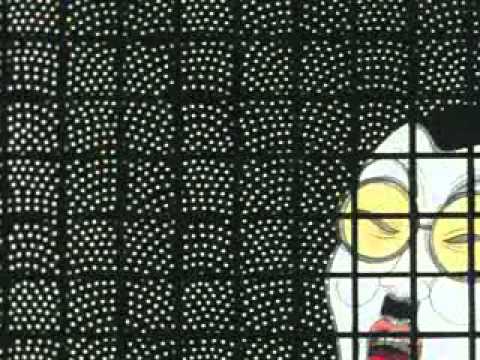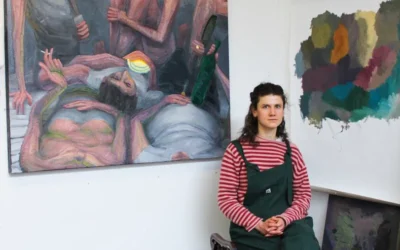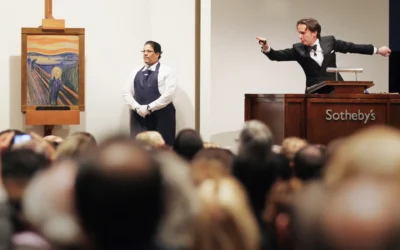This is not about the first wave of pop- says one of the curators of the exhibition on Pop Art just opened at Tate Modern. Not an exhibition on Andy Warhol, Richard Hamilton, and Roy Lichtenstein or any of those “Anglo-Saxons” who back in the sixties ridiculed the new consumer society by employing its language and strategies: billboards, brands, magazines, packaging designs, slogans, ready-mades, and etcetera. On the walls, the floors, the plinths, and in the videos, the so called “second wave of pop,” created by little-known artists coming from all the corners of the world whose merit has been to appropriate the style and the spirit of Pop to reflect on their respective political and social realities.
In Russia in the seventies, Vitaly Komar (b.1943) and Alexander Melamid (b.1945) produced a series of oils called Post Art which borrowed well-known images of Pop to represent the complex relationships between Soviet Union and North America. Burnt versions of Warhol’s Campbell Soup and Roy Lichtenstein’s fragments from the comic book: As I Opened Fire, are presented like relics from another era. Remnants of a catastrophe, fragments of a reality which can only be seen in bits and pieces, like the frieze of a Roman fresco in a decadent villa of Ercolano. An ironic comment on the Soviet Union’s fantasy of a catastrophe falling onto the American capitalist soil, or rather a laugh at the Russian’s desire to salvage American society from its deserved end? Whichever the answer, a fact is that the quintessentially pop device of appropriation is restaged to confront political issues, namely the Cold War.
In the seventies, Equipo Crònica, a collective of Spanish painters were articulating similar questions. In their 1968’s canvas Social Realism and Pop Art in the battlefield, they chose to represent the European concern over figuration during the Cold War. Their work combines one of Henry Rousseau’s (1844-1910) jungle with social realism images and pop logos. Again, the Campbell’s can, the various VOOMP! MAAHW, BRATATATA…, and a closer attention to this bright acrylic painting also shows that the whole battlefield is imagined as a cartoon’s speech bubble coming from El Greco’s mind. Is the Spanish’s (and therefore European) visual identity just possible as a comment on the fight between the two superpower centres? El Greco is the thinker, a Rousseau’s landscape the background, yet both seem to have been oversimplified and stripped of their original complexities and debased to an existence inside a comic book.
One of the surprises highlighted by our research- explains curator Jessica Morgan in her introduction of the show- was that Pop was happening in so many places at the same time, yet with isolated groups of artists in maybe very nearby countries (…) having little or no connection between them. In other word, the second wave of Pop was an intrinsically global phenomenon and if one of the merits of the exhibition is to show that, another is the discovery of a very peculiar strand within this new coined movement: the Japanese Pop.
Unlike other “second wave pop artists”, Japanese artists had by the 70s already developed a Pop tradition within their own culture, a Proto-Pop due to the country’s fascination with the west and its strong graphic culture. Both tendencies flourished during the seven years’ occupation that followed Japan’s defeat in the Second World War.
Ushio Shinohara’s (b.1932) Doll Festival, 1966, is one example of how the new Japanese Pop established itself as a continuation of the indigenous Proto Pop. Doll Festival, part of the artist’s Oiran series is inspired by the annual festival organised to pray for young girls’ growth; it also refers to the Japanese tradition of ukiyo-e, the 17th to 19thcenturies woodblock prints depicting everyday life in the city of Edo. This large three panels’ work made of plastic boards on plywood show five Japanese figures congregated under a cherry blossoms. Presumably culled from ukiyo-e prints, these figures have no expression and don’t give any clue of what they are up to. One of them wears a bowler hat with some chrysanthemums and two Japanese flags. The sense of a mismatch due to the juxtaposition of a Westernised outfit among Japanese clothing was already part of the Japanese culture, nut here an extra layer is added: the use of commercial art techniques, and cheap materials; the bright fluorescent colours; and artistic devices such as replication, multiplication and appropriation.
Keiichi Tanaami’s (b. 1936) Crayon Angel (1975) is also a comment on the brisk Americanisation of Japan and the feeling of ambivalence towards the coloniser seen as both a seducer and a destroyer. This three minutes video made of the artist’s hand-drawn images, documentary photographs plus film footage of the Pacific War, explores issues of individual and collective memory.
Dreamy and autobiographical, Crayon Angel is also an unusual record of the firebombing of Tokyo. The day Tanaami saw the bombs falling onto the Japanese capital fixed into his imagination. As life progressed, like his friend Shinohara, he became a serious student of American Pop Art, but his relationship with America kept its ambivalent nuances and questioning nature.
The reason why also Japanese Pop Art was dismissed in the first attempts to canonize the movement, comes as no surprise. Hundreds of artists who lived and produced outside London and New York, and used pop style as a device to voice their social and political convictions were ignored. This exhibition is an attempt to repair the omission and if it succeeds in showing and defining the features of a neglected pop, it also give the sense of being the theoretical product of a curatorial team rather than the display of a living phenomenon.
Despite the exhibition’s aim to provide a corrective to the canonised notion of Pop Art, The World Goes Pop reaffirms the first critics’ divide between the true Anglo-Saxon Pop and the “other pops.” Andy Warhol, Roy Lichtenstein and Richard Hamilton are definitely hovering in all the rooms restating their hegemonic presence.



